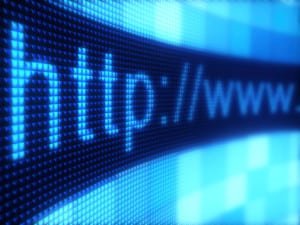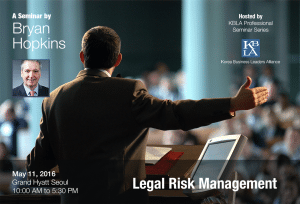 There is no doubt that privacy laws in Asia have become very important to businesses operating in the Asia Pacific region. Here is a brief summary of the privacy laws of several jurisdictions in Asia:
There is no doubt that privacy laws in Asia have become very important to businesses operating in the Asia Pacific region. Here is a brief summary of the privacy laws of several jurisdictions in Asia:
1. Australia- Australia’s privacy law was first enacted in 1988. It has been modified twice since then, most recently in 2012. (more…)
 For those of you who engage in business, everyone knows that properly managing risk plays an important part in the success of a company. However, though some companies may acknowledge the benefits of risk management , many don't consider legal risk management (LRM) processes when trying to mitigate or control and manage litigation risk issues, government investigations as well as legal liability. The benefits of ERM managment is never fully realized, leaving the company exposed to the tremendous costs associated with legal and corporate liability.
For those of you who engage in business, everyone knows that properly managing risk plays an important part in the success of a company. However, though some companies may acknowledge the benefits of risk management , many don't consider legal risk management (LRM) processes when trying to mitigate or control and manage litigation risk issues, government investigations as well as legal liability. The benefits of ERM managment is never fully realized, leaving the company exposed to the tremendous costs associated with legal and corporate liability. Recently, Korea has added new updates to its privacy laws, including the amended version of the Network Act (the “Amended Network Act”) and the amended version of its personal data privacy law- the PIPA (the “Amended PIPA”) . Both the Amended PIPA and the Amended Network Acts (collectively “Amended Acts”) contain a number of far-reaching amendments that raise the overall level of regulatory requirements applicable to information and communication service providers (“ICSPs”) and data processors. (more…)
Recently, Korea has added new updates to its privacy laws, including the amended version of the Network Act (the “Amended Network Act”) and the amended version of its personal data privacy law- the PIPA (the “Amended PIPA”) . Both the Amended PIPA and the Amended Network Acts (collectively “Amended Acts”) contain a number of far-reaching amendments that raise the overall level of regulatory requirements applicable to information and communication service providers (“ICSPs”) and data processors. (more…)
 Despite the recent emphasis by many countries on data privacy, data privacy issues have only gotten worse. What the world is currently experiencing is the explosion of data (Big Data) as well as a breakdown in data privacy safeguards due to risk issues as well as increased technology making data privacy much harder to control. (more…)
Despite the recent emphasis by many countries on data privacy, data privacy issues have only gotten worse. What the world is currently experiencing is the explosion of data (Big Data) as well as a breakdown in data privacy safeguards due to risk issues as well as increased technology making data privacy much harder to control. (more…)
 Considering that the CES Show in Vegas is in full swing as well as the recent events in North Korea and China involving cybersecurity,etc, I think it is fitting to offer a post by a friend, Mike O'Brien at Wilson, Elser on the risks inherent in IoT devices. Here is his post .
Considering that the CES Show in Vegas is in full swing as well as the recent events in North Korea and China involving cybersecurity,etc, I think it is fitting to offer a post by a friend, Mike O'Brien at Wilson, Elser on the risks inherent in IoT devices. Here is his post .
The Internet of Things: The Inevitable Collision with Product Liability
By H. Michael O'Brien (White Plains, NY) on February 2, 2015 Posted in Product Liability, Technology and electronic products
The IoT – Internet of Things – is undergoing a rapid development that will continue to transform how we interact, conduct business and live our lives. The movement toward IoT’s ubiquitous application and use does not come without risk and, while some of the consequences can be easily predicted, many will not be fully understood for some time to come.
One area that will be impacted is product liability. The advent of smart devices will have far-reaching consequences for manufacturers and software developers to tech service companies, insurers and, most certainly, consumers. The U.S. Federal Trade Commission (FTC) issued a report in January 2015 that highlights and forecasts these very concerns.
The FTC report noted security concerns for consumers using IoT devices, such as enabling unauthorized access and misuse of personal identification, facilitating attacks on other systems and creating safety risks. It was noted that while these risks exist on traditional computers and computer networks, they are heightened in the IoT.
What Is the Internet of Things? The IoT has been identified as the third wave of the Internet. Various estimates and predictions suggest that as many as five billion devices are connected to the Internet and there will be 25 billion more within five years. The revenue stream from the IoT is expected to exceed $300 billion.
The IoT enables devices to connect to the Internet via embedded sensors built into the devices. These embedded sensors send environmental and activity information to data storage centers that in turn allow analytic engines to provide feedback and control. The IoT has transformed everyday devices into smart devices connecting consumer objects and industrial equipment to the Internet, enabling information gathering and management of these devices via software to increase efficiency, enable new services, or achieve other health, safety and environmental benefits.
A 2014 Goldman Sachs report identified five key IoT areas of adaption: wearables (e.g., smart bands), connected cars, connected homes, connected cities and industrial Internet (including transportation, oil & gas and health care).
Primary Market Forces The report identified primary market forces driving the growth of IoT, including low-cost enablers such as cheaper sensors, bandwidth and processing; smartphones and ubiquitous wireless coverage; the value proposition from revenue generation by new product cycles; and productivity and cost savings.
More than 900 exhibitors showcased IoT technologies for the home, cars, security systems and kitchen appliances at the 2015 Consumer Electronics Show.
Each day new products and services for businesses and the home are becoming IoT-connected. For the home, the primary reasons are twofold:
Security Concerns The proliferation of applications for IoT devices is raising concerns with respect to the security of these devices and the purposes for which personal data collected will be used. The use of IoT technology therefore introduces a new layer of risk for these products, which raises concerns about privacy and the potential for outside interference by individuals or groups with nefarious motives.
Could the vulnerability of IoT devices and products actually encourage such attacks against consumers? The answer is probably yes. A study released by Hewlett-Packard in 2014 found 70 percent of IoT devices are vulnerable to attack. The vulnerabilities identified in the report include password security, encryption and general lack of granular user access.
In 2014, the German government’s federal office for information security (the BSI) released details of an attack on the network of a steel plant. The perpetrators eventually gained access to the plant’s production network and other systems and took control of a blast furnace, preventing it from shutting down, which caused massive damage to the system. This was identified as the second cyber-attack to cause physical damage; the first known attack was the Stuxnet malware attack on the Natanz uranium enrichment plant in Iran.
In the consumer setting, the FTC report provides some examples of potential vulnerabilities:
The FTC report notes that the proliferation of inexpensive IoT devices may be part of the risk to consumers. IoT device makers may not be attuned to the security issues and lack the economic incentives to provide software updates and support when vulnerabilities are discovered.
In the private sector, similar concerns are being voiced. Michael Coates, director of product safety at Sharpe Security and chairman of OWASP (Open Web Application Security Project), has predicted that the lack of updates to IoT consumer devices will become an area of vulnerability for manufacturers because it will “be a very low priority for the manufacturer.” Coates also predicts “criminal organizations will run their malicious activities in the background without impacting the overall performance of the device and this will mean the customer will not notice the malware, and the security vulnerability will have no impact on the performance of the device. These kinds of vulnerabilities could result in the loss of private data that will be monitored and sold without their knowledge.”
Coates, like the FTC, forecasts effective patches as a problem: “Once it is discovered, the manufacturer will rush to issue a patch. But, how will the patch be delivered? Will consumers have to reboot their oven? Will the updated software only be available in the next release of the physical product?”
The Impact on Product Liability There are at least three areas of vulnerability for consumers and businesses that are fairly predictable:
These types of problems, if widespread within a product line found to be vulnerable to such malfunctions and attacks, could lead to product liability law suits and class action litigation by the affected consumers.
Liability and Consequences In each of these hypothetical situations, one can ask: “Who will play a role in the allocation of fault and who will bear the financial consequences?”
Under the traditional principles of strict liability, fault flows up the chain of distribution from the retailer through mid-channel distributors ultimately to the manufacturer. But will the software developer for an IoT product or handheld device be brought into the equation when an IoT product causes a loss? Who will bear the responsibility if the software is vulnerable to an outside attack? These risks are often addressed between parts suppliers and manufacturers under the terms of supply agreements where a contractual duty to defend and indemnify against damages caused by a malfunctioning device is spelled out.
What role will the consumer play? Will the consumer become a target for fault apportionment if it is found that the consumer failed to update security software or used easily hacked passwords or downloaded malware from unsecure sites? What issues of privacy will develop when litigation is brought and demands are made by potentially liable third parties to examine the device used by the consumer and download its contents? What issues of privacy will arise when information downloaded from an IoT product is stolen? What issues of privacy will exist when information collected from an IoT-connected device is sold by the IoT device manufacturer to a third party?
How will the losses be investigated and will responsibility for failure of an IoT product prove more difficult to investigate and thus to establish liability? What types of experts will now be called on to play a role in the investigation?
Wilson Elser has been examining and evaluating the potential impact of the IoT across several distinct but interrelated legal practice areas and has taken an integrated, multi-practice approach to inform and advise our clients as to the potential impact the IoT will have on various stakeholders and business interests. Wilson Elser has specific practice area specialists who are knowledgeable about the issues emerging with IoT applications. Consequently, the firm is positioned to help guide clients through myriad complexities and issues to avoid or reduce risks. In the worst-case scenario Wilson Elser is positioned to act as a first responder when the inevitable problems emerge. Wilson Elser hosts CL and CLE programs on the IoT for our clients and interested businesses. For more information, please direct inquiries to michael.obrien@wilsoneleser.com.
 Successful Risk Management Requires A View From The Top Not A View From The Trenches
Successful Risk Management Requires A View From The Top Not A View From The Trenches
Today I was fortunate to visit a large electronics company in Seoul. In fact, I was on the 39th floor of the company located in southern Seoul and had an amazing view of Seoul- as evidenced by the picture to the left. (more…)